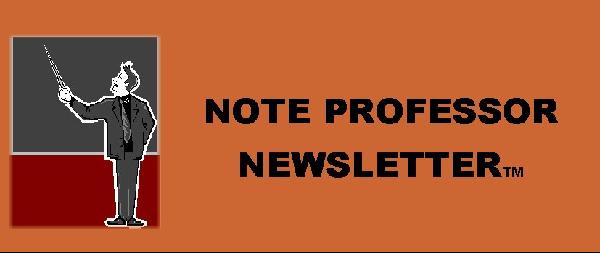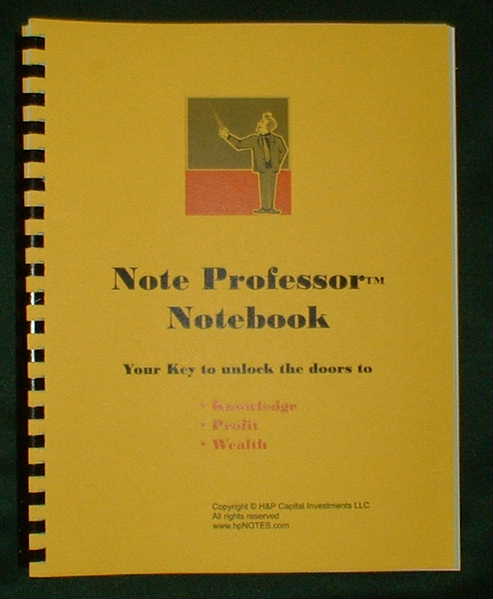|
|

|
|
||||||
|
||||||
| by Tom Henderson |
If you browse the newsletter archives, in October/03, I wrote a series of articles on “How To Structure a Note To Sell at Closing”www.hpnotes.com.While this gives you insight on the "3 P’s" ---people, property, and paper, most of the paperwork will be generated at closing. What if you have a seasoned note?. Since everybody wants the closing to take place lightning fast, what do you need to make sure you note sale goes through smoothly and a fast as possible. Here is a check list of the basic documents you should have ready to submit immediately before even asking for a quote. Having the docs at hand will cut down on the time it takes to do due diligence, as well as providing enough information to even get a quote. 1. Original signed note. Make sure it is the original. Copies are not acceptable. Not having the original means there is going to be lengthy and sometimes complicated paper work to complete before the note can be purchased. When you sell your property using owner financing, make sure you walk away from closing with the original note and put it in a safe place. 2. Recorded deed of trust or mortgage 3. Contract of sale (We are going to need the contract at the beginning of the due diligence process) 4. Closing statement (HUD) 5. Title and mortgagee insurance. (When you sell your property, be sure to get mortgagee insurance at the same time as the title insuranceThe cost is nominal and will save you money if you sell your note in the future) 6. Information on the payor. Since you are going to be lending someone ten's, if not hundred's of thousands of dollars, you should have a completed loan application and/or credit report, before you sold your property. If you do not have a loan application form, email me, and I will send you one. Having information on the payor will prevent finding out when you try to sell your note that the payors have a sub 500 credit score, and your note is virtually worthless. At the least, be sure to get their SS#. You are going to need it to file your 1098s, and we can readily pull credit so we can give you a firm bid, and not a contingent bid. 7. Payment history and proof of payments. When you receive your payments, make copies of the checks and/or deposit slips to your bank. I will furnish you with a payment history form, if you email me. Keep good records of your payments. 8. Hazzard insurance. Have proof of insurance with you as a loss payee. When you have these documents ready, the closing will be quick and smooth, and everybody smiles. Remember, if you know of someone who has a note to sell, be sure to contact me. I pay referral fees. If you have questions or comments contact me. It is from your questions that I develop topics for the newsletter. Copyright H&P Capital Investments LLC. All rights reserved |
|||||
|
||||||
| by Tom Henderson |

When ever you take back a note, or when you
purchase a note, there are several ways to make
your note more valuable.
For those who have taken my class, know the phrases “The More the Merrier” and “The Sooner The Better” and ”More is Better Than Less” and “Sooner is Better than Later”. Here is a technique, that by tweaking the variables you can do both at the same time. In THE NOTE PROFESSOR NOTEBOOK, I gave the example where we bought a $10,000 note for $6,000. Here is what the deal looked like: Original Note: N = 120 I = 7% PV = $10,000 PMT = $116.11 FV = 0 After our purchase, here is what the note looks like: N = 120 I = 20.04 % WOW!!!! PV = $6,000 (Amount I paid for note) PMT = $116.11 FV = 0 We go to the payor and asked him if we cut the interest rate in half, would he double his payments? He said, “yes”..Why? Let’s look. N = 46.08 (Notice how N decreased..Is this advantageous to the seller..YOU BET) I = 3.5% PV = $10,000 (Even though I purchased at $6,000, it remains $10,000 for payor) PMT = $232.22 FV= 0 $232.22 x 46.08 = $10, 700.70 $116.11 x 120 = $13,933.20 Do you see why the payor would go for this deal. He is saving over $3,000, while building up equity in less than 4 years. Good deal for payor. What does it do for us? N = 46.08 I = 33.08% Double WOW!!! PV = $6,000 PMT = $232.22 FV = 0 Remember.SOONER IS BETTER THAN LATER AND MORE IS BETTER THAN LESS? Here we did both. Increased our payments, and shortened the time we got it. What did it do to our yield, it increased it to 33.08%. In the next chapter, I show how I tweaked this same deal further to increase the yield to, dare I say it, 75%. How? That is for another news letter. What I want you to see and grasp here is the concept of how changing variables, will change values. You can make a mint doing this. THE NOTE PROFESSOR NOTEBOOK is now for sale on Ebay for $69.99 This is a $30 savings. Merely go to www.ebay.com and search for NOTE BUYING. If it is sold out, check back to Ebay during November. Remember, if you know of someone who has a note to sell, be sure to contact me.I pay referral fees. Send me your questions or comments. You guys are the ones who give me the topics you like to read. Copyright H&P Capital Investments LLC All rights reserved |
|||||
|
||||||
|
Combined Loan-to-Value (CLTV).
The total of all loans relative to the value of the property. For example, if a property is being sold for $100,000 and has a $90,000 1st lien and a $5,000 2nd lien, it is said that the CLTV is 95%. |
||||||
|
||||||
|
"Change is inevitable-except from a vending machine."
Robert C. Gallegher |
||||||
|
||||||
|
||||||